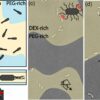In 2018, a team of physicists at Purdue University invented a device which experimentally showed quasiparticles interfering for the first time in the fractional quantum Hall effect at filling factor v=1/3. Further development of these heterostructures has allowed the Manfra Group to expand their research to experiments that explore counterflowing charged edge modes at the 2/3 fractional quantum Hall state.
They have recently published their findings, “Half-Integer Conductance Plateau at the ν = 2/3 Fractional Quantum Hall State in a Quantum Point Contact,” in Physical Review Letters. This novel work has been selected as the Editor’s Suggestion for the forthcoming issue.
The team is led by Dr. Michael J. Manfra, Bill and Dee O’Brien Distinguished Professor of Physics and Astronomy, Professor of Electrical and Computer Engineering, Professor of Materials Engineering, and Scientific Director of the Microsoft Quantum Lab West Lafayette. The lead author of the publication is Dr. James Nakamura, senior research scientist. Dr. Geoffrey Gardner and graduate student Shuang Liang were also co-authors of this publication making valuable contributions to heterostructure growth.
In the experiment, the team produced a semiconductor material which contains a sheet of two-dimensional electrons. On top of this semiconductor, they built a quantum point contact which consists of metal gates with a very narrow 300 nanometer gap. They used the quantum point contact to direct the conducting edge states through the narrow gap.
In this configuration, demonstrated by the graphic above, they were able to measure an electrical conductance equal to half the fundamental value of e2/h. This experimental result is consistent with longstanding theoretical predictions for the edge states of the ν = 2/3 fractional quantum Hall state.
“We have a semiconductor structure that contains electrons arranged in a plane, called a two-dimensional electron system. When you cool the electrons down to low temperature and put them in a strong magnetic field, they form special states of matter called quantum Hall states,” explains Nakamura.
“At a certain value of the magnetic field, the quantum Hall state is called the ν = 2/3 fractional quantum Hall state. At all quantum Hall states, electrical current is carried by edge states that flow around the edge of the sample, and they are chiral, meaning each edge state only flows in one direction (clockwise or counterclockwise). The ν = 2/3 state is predicted by theoretical physicists to have the special property that the there are two edge states which flow in the opposite direction to each other, one clockwise and the other counterclockwise.”
“This is different from most quantum Hall states, where all the edge states flow in the same direction. We used a device with metal gates called a quantum point contact to control the edge states, and our measurements of the edge states in the quantum point contacts confirm the counterflowing edge states in our device.”
“The quantum point contact brings the edge states on opposite edges of the sample close together. We measured a value of electrical conductance across the device equal to half of the value e2/h, where e is the electron’s charge and h is Planck’s constant. This value of the conductance is strong experimental evidence that our system has the edge structure with two counterflowing edge states.”
This research is part of an ongoing quest to understand and manipulate fractionally charged anyons in fractional quantum Hall regime, a rich testbed for exploring the impact of topology in condensed matter physics which may possibly be used to create qubits.
More information:
J. Nakamura et al, Half-Integer Conductance Plateau at the ν=2/3 Fractional Quantum Hall State in a Quantum Point Contact, Physical Review Letters (2023). DOI: 10.1103/PhysRevLett.130.076205
Citation:
Heterostructures support predictions of counterpropagating charged edge modes at the v=2/3 fractional quantum Hall state (2023, February 23)



